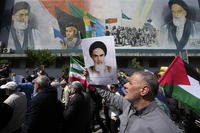More than 30 U.S. airstrikes over the past two days in Yemen had long been planned and were not the result of intelligence gained from the Jan. 29 raid in which Navy SEAL William "Ryan" Owens was killed, a senior U.S. defense intelligence official said Friday.
The official said that SEAL Team 6 came away from the raid against an Al Qaida in the Arabian Peninsula compound with "potentially actionable" intelligence on AQAP leadership and activities, but that information was not useful for the airstrikes.
"We found an awful lot of telephone numbers, lots of contact information and things like that" at the AQAP compound in the action in which Owens, 36, of Peoria, Illinois, was killed, said the official, who spoke to Pentagon reporters on grounds of anonymity.
"So that helps us understand who's within the network and who's tied to who and who's connected to who, which then allows us to draw that mosaic of what the group is and how it's situated," the official said. "Then it's a policy question as to what you do about it."
"It's definitely helping us understand the network and further develop it out," the official said. "This has been good information" and "we're happy to have it."
At an earlier Pentagon press briefing, Navy Capt. Jeff Davis, a Pentagon spokesman, said that at least 25 airstrikes against AQAP, using manned and unmanned aircraft, were carried out Thursday and several more Friday for a total of more than 30.
He also stressed that there was no connection between the airstrikes and the Jan. 29 raid.
"All of the targets were developed prior to the raid in January," Davis said, and "the planning for this was developed well before Jan. 20," the date of President Donald Trump's inauguration.
Davis denied reports from the region that U.S. infiltration teams had been inserted into Yemen and had engaged in firefights during the airstrikes.
"There have not been firefights," he said, while acknowledging that "we do have U.S. forces that go in and out of Yemen" on occasion.
All of the airstrikes were coordinated with the exiled government of Yemeni President Abdrabbuh Mansur Hadi and were concentrated in the central mountainous area where the governorates of Abyan, Al Bayda and Shabwah converge, Davis said.
Sadek al-Jaouf, a Yemeni tribal leader, told The Associated Press that airstrikes hit the Yaklaa district of Al Bayda, which was the site of the Jan. 29 raid.
In addition to Owens' death, three other team members were wounded in what U.S. Central Command described as a "ferocious firefight" and at least two were injured in the hard landing of a Marine MV-22 Osprey tilt-rotor aircraft.
The $70 million aircraft could not be flown out and had to be destroyed by a Marine AV-8B Harrier jet flying off the amphibious assault ship Makin Island in the Red Sea.
Davis suggested that the airstrikes would be part of a sustained campaign against AQAP to break up potential terrorist plots against Europe and the U.S. and aid Hadi's forces in Yemen's long-running civil war.
"In some ways, you could say we already have a civil war within the civil war," the senior defense intelligence official said.
Hadi's forces, backed by the United Arab Emirates and Saudi Arabia, are battling Shia Houthi rebels allied with former Yemeni President Ali Abdullah Saleh. AQAP has flourished in the ungoverned spaces, sometimes opposed to and sometimes allied with a small contingent of Islamic State of Iraq and Syria fighters operating in Yemen, the official said.
-- Richard Sisk can be reached at Richard.Sisk@Military.com.




























